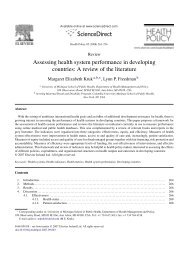Part II Community-Based Forest Management Program - ppmrn
Part II Community-Based Forest Management Program - ppmrn
Part II Community-Based Forest Management Program - ppmrn
You also want an ePaper? Increase the reach of your titles
YUMPU automatically turns print PDFs into web optimized ePapers that Google loves.
SOUND IMPLEMENTATION AND MAINTENANCE STRATEGIES/ACTIVITIES<br />
<strong>Management</strong>’s Comments<br />
For the upland people, land is life and<br />
therefore seldom they compromise if<br />
we tend to deprive them of their<br />
traditional land use. The win-win<br />
solution therefore, is for them to plant<br />
permanent crops with economic value<br />
for survival. In this case, we still have<br />
permanent forest and at the same time<br />
addressed their survival. The increase<br />
in soil erosion should not be<br />
interpreted as a negative impact and a<br />
long term scenario. This condition<br />
will usually occur in the site<br />
development stage where soil tillage is<br />
inevitable, but the moment permanent<br />
crops get establish on the ground and<br />
effectively sustained local economic<br />
activities, slope stabilization is a long<br />
term scenario. Unless we will be<br />
more sensitive to their culture and<br />
survival, then there will be less fire<br />
occurrences in our natural forest.<br />
Kaingin farming is considered as one<br />
of the practices promoting soil<br />
erosion, but it is widely practiced in<br />
the CBFMA (PWRS) area. Traditional<br />
farming system is regarded worldwide<br />
as sustainable farming system due to<br />
their unique way of preserving their<br />
fertile soil. Research showed that one<br />
of these practices is the so called<br />
FALLOW method. This is method<br />
allows planting area to rest for five (5)<br />
years or more and thereafter cleared<br />
again. In the case of the OSA CBFMA<br />
where soil are fertile, most of the fast<br />
growing native species already attain<br />
the height and diameter which when<br />
cut for the follow period can already<br />
be construed as kaingin. While we do<br />
not advocate this practice of cutting<br />
miscellaneous trees, but there is a<br />
difficulty in transforming their<br />
practices overnight. This can be<br />
Team’s Rejoinder<br />
The kaingin noted by the team could<br />
not be that of Fallow Method as the<br />
trees cut off were the newly<br />
established plantation under the CSD<br />
contract and not the fast growing<br />
native species that have attained the<br />
required height and diameter.<br />
74





